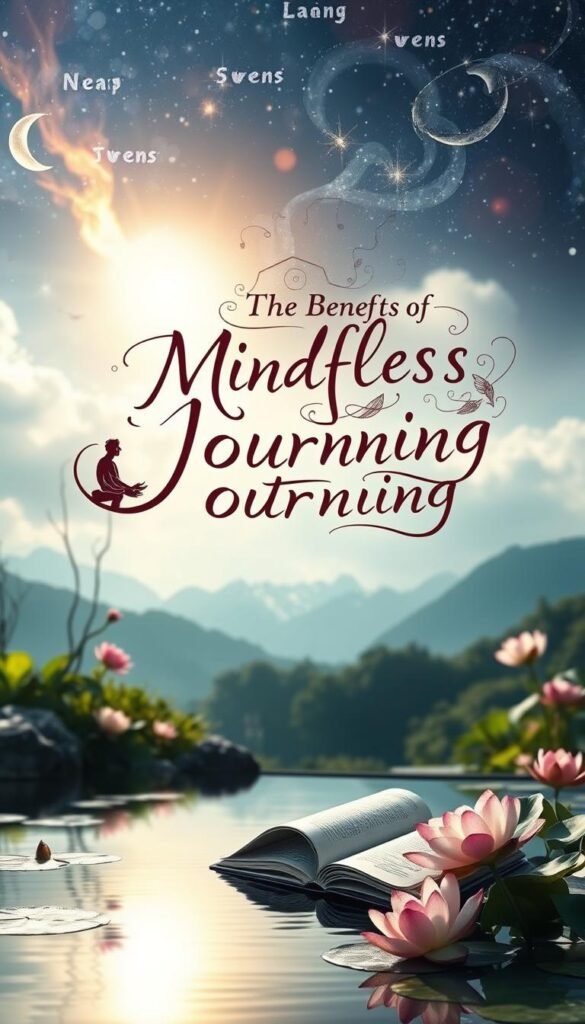In today’s fast-paced world, we often find ourselves overwhelmed by constant connectivity and emotional exhaustion. How often do we truly pause to connect with ourselves? The demands of modern life can leave us feeling scattered and disconnected from our inner selves.
Enter mindfulness journaling—a simple yet powerful practice that bridges ancient wisdom with modern science. By putting pen to paper, we create a space to process our thoughts and emotions. This practice not only fosters calm but also brings clarity to our daily lives.
Research shows that journaling can build resilience and improve mental health. It’s a tool that’s accessible to everyone, requiring nothing more than a notebook and a few minutes of your time. Whether you’re new to this practice or a seasoned writer, mindfulness journaling offers a path to deeper self-awareness and peace.
As featured on Today.com, tools like the Daily Wellness Planner make it easier than ever to integrate this practice into your routine. It’s not just about writing—it’s about creating a ritual that nurtures your mind and soul.
Key Takeaways
- Modern life often leads to emotional exhaustion and disconnection.
- Mindfulness journaling is a practical and accessible self-care tool.
- It helps process thoughts and emotions, fostering calm and clarity.
- Scientific research supports its benefits for mental health and resilience.
- Tools like the Daily Wellness Planner can simplify the practice.
What Is Mindfulness Journaling?
In a world filled with distractions, finding moments of clarity can feel like a rare gift. Mindfulness journaling is a way to create those moments by focusing on the present moment. It’s an active conversation with your inner wisdom, allowing you to process your thoughts emotions without judgment.
Understanding the Basics
This type journaling is rooted in Buddhist traditions but adapted for modern life. Unlike traditional diary writing, it’s not about recounting events. Instead, it’s about exploring your inner world. You might write in a stream-of-consciousness style, letting your thoughts flow freely.
One common misconception is that mindfulness journaling requires perfect grammar or structure. It doesn’t. The goal is to cultivate awareness, not to create a polished piece of writing.
How It Differs from Other Journaling Practices
While bullet journaling focuses on productivity and faith journals on spirituality, mindfulness journaling is about presence. It’s a mindfulness practice that encourages you to slow down and observe your thoughts and feelings.
Here’s a comparison of different journaling styles:
| Type | Focus | Purpose |
|---|---|---|
| Fitness Journals | Tracking progress | Physical health |
| Faith Journals | Spiritual growth | Inner peace |
| Mindfulness Journals | Present moment awareness | Emotional clarity |
This table highlights how mindfulness journaling stands apart. It’s not about achieving goals or seeking answers. It’s about being present with your thoughts and emotions, creating a space for self-discovery.
The Benefits of Mindfulness Journaling

Navigating through life’s challenges often requires more than just surface-level solutions. Mindfulness journaling is a powerful tool that offers profound benefits for your mental and emotional well-being. It’s not just about writing—it’s about creating a space to explore your inner world and build resilience.
Increased Self-Awareness
Mindfulness journaling acts as a mirror for the soul, helping you uncover patterns in your thoughts and emotions. Neuroscience shows that writing activates the prefrontal cortex, the part of the brain responsible for regulation and self-awareness. This process, often called emotional archaeology, allows you to dig deeper into your experiences and understand yourself better.
Improved Emotional Regulation
By putting your thoughts on paper, you create a safe space to process emotions. A client case study from social work research highlights how this practice helps individuals manage overwhelming feelings. Writing encourages the brain to organize thoughts, leading to improved emotional regulation and a calmer mind.
Reduced Stress and Anxiety
Stress is a common part of modern life, but mindfulness journaling can help. Studies from Harvard Health show that writing reduces cortisol levels, the hormone linked to stress. This practice allows you to release pent-up emotions, creating a sense of relief and calm. Incorporating workplace mindfulness techniques can further enhance this calming effect. By taking short breaks to reflect and jot down thoughts throughout the day, employees can decrease their stress levels and improve their overall productivity. Over time, these practices foster a more positive work environment, benefiting both individual well-being and team dynamics.
| Benefit | Impact |
|---|---|
| Self-Awareness | Helps recognize thought patterns |
| Emotional Regulation | Improves ability to manage emotions |
| Stress Reduction | Lowers cortisol levels |
Mindfulness journaling is more than a habit—it’s a journey. It starts with awareness, moves to regulation, and ultimately builds resilience. By making it a part of your routine, you can transform your mental and emotional health, one page at a time.
How to Practice Mindful Journaling

The art of mindful writing begins with small, intentional steps. It’s not about perfection but about creating a space where your thoughts can flow freely. Whether you’re new to this practice or looking to deepen it, these tips will guide you on your journey.
Setting Up Your Space
Your environment plays a key role in your journaling practice. Start by choosing a quiet corner where you feel at ease. Add a few personal touches—like a candle or a cozy blanket—to make it inviting. A phone-free zone can help you stay focused and present.
Think of this space as a sacred container for your thoughts. It’s a place where you can let go of distractions and connect with your inner self. Even if you only have five minutes, this setup ensures you make the most of your time.
Establishing a Routine
Consistency is key to building a lasting habit. Choose a time of day that works best for you—whether it’s morning intention setting or evening reflection. Start with just a few days a week and gradually increase as it becomes part of your routine.
Here’s a simple template to get started:
- Morning: Write about your intentions for the day.
- Evening: Reflect on your experiences and emotions.
This approach helps you create a rhythm that feels natural and sustainable.
Writing Without Judgment
One of the most important aspects of mindful writing is letting go of judgment. Treat your journal as a safe way to explore your thoughts and feelings. Don’t worry about grammar or structure—just let your words flow like passing clouds.
If you encounter emotional overwhelm, pause and take a deep breath. Remember, this practice is about processing, not perfection. Each page is a step toward greater clarity and understanding.
| Challenge | Solution |
|---|---|
| Lack of Time | Start with 5-minute sessions |
| Emotional Overwhelm | Pause and breathe deeply |
| Self-Judgment | Focus on process, not perfection |
By creating a supportive space, establishing a routine, and writing without judgment, you can make mindful journaling a transformative part of your life. It’s a way to connect with your mind and find peace in the present moment.
What to Write in a Mindfulness Journal

Finding clarity in the chaos of daily life can feel like a treasure hunt. Your journal is the map that guides you through this journey. It’s a space to explore your feelings, reflect on your experiences, and uncover the hidden gems of your inner world.
Gratitude Entries
One of the most powerful exercises you can do is gratitude mapping. This technique involves listing things you’re thankful for, but with a twist—add sensory details. For example, instead of writing “I’m grateful for my morning coffee,” describe the aroma, the warmth of the cup, and the quiet moment it brings. This practice deepens your appreciation and anchors you in the present.
Self-Reflection Prompts
Self-reflection prompts act as doorways to deeper understanding. Questions like “What challenged me today?” or “What brought me joy?” encourage you to explore your emotions without judgment. These prompts can lead to profound insights, helping you connect with your true self.
Mindfulness Practices and Experiences
Your journal can also be a canvas for creative expression. Try sketching your emotions alongside your words. This fusion of art and writing allows you to process feelings in a new way. Another technique is the “Word Dump,” where you write freely for a set time, releasing pent-up emotions without editing or censoring.
Here’s an example entry showing vulnerability progression:
“Today, I felt overwhelmed. I started by listing my frustrations, but as I wrote, I realized they stemmed from fear. Acknowledging this fear felt like lifting a weight off my chest.”
Contrast transactional writing—like to-do lists—with exploratory writing, which focuses on understanding your inner world. The latter fosters emotional growth and clarity, making your journal a true companion on your journey.
How to Start a Mindfulness Journal

Starting a journal can feel like opening a door to your inner world. It’s a place where you can explore your thoughts, set goals, and navigate life’s challenges. Whether you’re new to this practice or looking to refresh your routine, these steps will guide you.
Choosing the Right Journal
The first step is selecting a journal that feels right for you. Physical journals offer a tactile experience—the texture of the paper, the weight of the cover. For some, this creates a deeper connection. Digital journals, on the other hand, are convenient and portable.
Consider your lifestyle. A leather-bound journal might inspire creativity, while a spiral notebook is practical for on-the-go writing. The key is to choose something that feels inviting and aligns with your goals.
Setting Intentions
Before you start writing, take a moment to set intentions. This could be as simple as a quiet moment of reflection or a ceremonial act, like a full moon ritual. Intentions give your journaling purpose and direction.
For example, you might write: “Today, I will explore my emotions without judgment.” This sets the tone for your practice and helps you stay focused on your goals.
Overcoming Common Challenges
Blank page anxiety is a common hurdle. Try the smear-and-write technique—scribble on the page to break the perfectionism barrier. Then, write freely. Remember, missed days don’t erase progress. Consistency is important, but so is self-compassion.
Here’s a quick guide to overcoming challenges:
| Challenge | Solution |
|---|---|
| Blank Page Anxiety | Smear-and-write technique |
| Inconsistency | Normalize missed days |
| Lack of Time | Start with 5-minute sessions |
By addressing these challenges, you can make journaling a sustainable and rewarding part of your life.
Daily Mindful Journal Prompts to Inspire You
Daily writing can transform how you see the world and yourself. Whether you’re seeking clarity or a deeper connection with your feelings, prompts can guide your journey. They act as gentle nudges, helping you explore your inner world with intention and curiosity.
Gratitude Prompts
Gratitude is a powerful way to shift your perspective. Try prompts like:
- What three things brought me joy today?
- Describe a moment when you felt truly supported.
- Write about a small pleasure you often overlook.
Theseexerciseshelp you focus on the positive, even on challenging days.
Emotional Reflection Prompts
Emotional prompts encourage you to dive deeper into your feelings. For example:
- What emotion is most present in my mind right now?
- How did I handle a difficult situation today?
- What’s one thing I’m proud of this week?
These questions foster self-awareness and emotional growth.
Mindfulness Practice Prompts
Mindfulness prompts anchor you in the present moment. Try these:
- Describe the sensations in your body right now.
- Write about a sound you hear and how it makes you feel.
- Reflect on a recent experience using all five senses.
Thesepromptshelp you cultivate presence and awareness.
“Writing is a way to process life’s ups and downs. It’s not about perfection—it’s about progress.”
| Prompt Type | Time Commitment |
|---|---|
| Gratitude | 2 minutes |
| Emotional Reflection | 5 minutes |
| Mindfulness Practice | 10 minutes |
By incorporating these prompts into your daily routine, you can create a meaningful practice that nurtures your mind and soul. Whether it’s a quick gratitude list or a deep emotional reflection, each day offers a new opportunity for growth.
Mindfulness Journaling for Stress Relief
Life’s demands can weigh heavily, leaving us searching for ways to lighten the load. Stress is a natural part of life, but how we handle it makes all the difference. Writing can be a powerful tool to process and manage stress, turning it into an opportunity for growth.
Identifying Stressors
Understanding what triggers your stress is the first step toward managing it. Try the Stress Mapping exercise: create a timeline of your day and note moments when you felt overwhelmed. This helps you pinpoint patterns and take proactive steps.
Another effective technique is building emotional granularity. Expand your vocabulary with a list of 50 emotion words. For example, instead of saying “I’m stressed,” you might write “I feel anxious” or “I’m frustrated.” This clarity helps you address the root cause of your stress.
Writing Through Emotions
When emotions feel overwhelming, the Word Dump technique can help. Set a timer for 10 minutes and write freely without editing. This process allows you to release pent-up feelings and gain perspective.
Neuroscience shows that writing activates the amygdala, the brain’s emotional center. This helps regulate emotions and reduces stress. A case study during the pandemic found that journaling helped individuals process anxiety and build resilience.
Reflecting on Stress Management
After writing, take time to reflect. Contrast suppression—bottling up emotions—with expression—writing them out. Studies show that expressing emotions leads to better mental health and reduced stress levels.
Create a stress-to-strength narrative. Write about how you’ve overcome challenges in the past. This reframes stress as a stepping stone rather than a roadblock.
“Writing is not just about releasing stress—it’s about transforming it into strength.”
By identifying stressors, writing through emotions, and reflecting on your experience, you can turn stress into a tool for growth. It’s a way to reclaim your time and focus on what truly matters.
Integrating Mindfulness Journaling into Your Daily Life
Transforming daily routines into moments of self-discovery can be a game-changer. By weaving journaling into your life, you create a space for reflection and growth. It’s not about adding more to your plate but finding a way to make your existing habits more meaningful.
Making It a Habit
Building a consistent practice starts with small steps. Try habit-stacking—pair journaling with an existing routine, like “after meditation, before coffee.” This creates a natural flow and makes it easier to stick to.
For busy days, introduce “Journal Sprints”—short, focused sessions of 5-10 minutes. These bursts of writing can help you stay connected to your goals without feeling overwhelmed.
Combining with Other Mindfulness Practices
Journaling pairs beautifully with other mindfulness meditation techniques. After a yoga session, take a few minutes to write about how your body feels. This synergy deepens your awareness and enhances the benefits of both practices.
Parents, executives, and students can all adapt this practice to their unique lifestyles. For example, parents might journal during nap time, while students can use it as a study break.
Tracking Progress and Growth
Seasonal reflection rituals can help you see how far you’ve come. Every three months, review your entries and note patterns or shifts in your life. This helps you celebrate progress and set new intentions.
Here’s a simple annual review template using journal entries:
| Quarter | Focus |
|---|---|
| Q1 | Reflect on winter experiences |
| Q2 | Assess spring growth |
| Q3 | Evaluate summer energy |
| Q4 | Plan for fall transitions |
“Small steps lead to big changes. Consistency is the key to transformation.”
By integrating journaling into your daily life, you create a powerful tool for self-discovery and growth. It’s a way to stay grounded, even in the busiest of times.
Conclusion
Every step you take in your journaling journey brings you closer to understanding yourself. It’s not about perfection—it’s about progress. Each entry is a step toward clarity, helping you see how far you’ve come and where you’re headed.
Before you started this practice, life might have felt overwhelming. Now, you’re building a habit that fosters self-awareness and emotional growth. Your imperfect words matter because they reflect your authentic self.
Ready to take the next step? Join our 30-day challenge to deepen your journaling routine. As Rumi once said, “The wound is the place where the light enters you.” Your journal is where you let that light in.
Explore the benefits of the Daily Wellness Planner and share your journey with our supportive community. Together, we can create a space for growth, healing, and connection.
